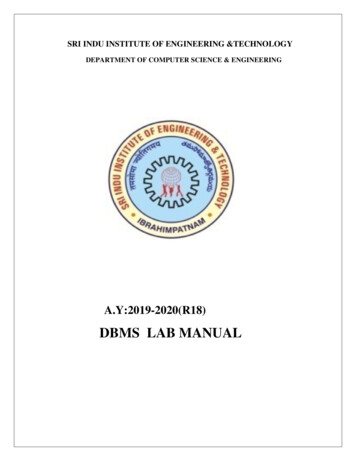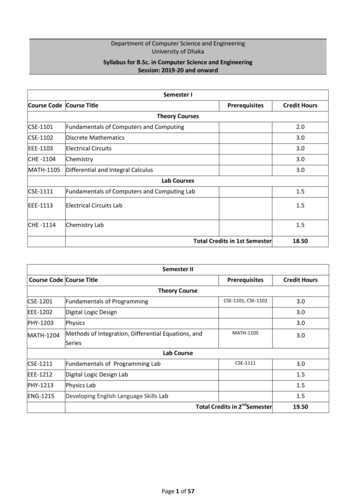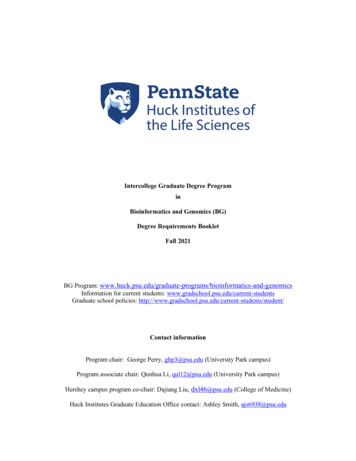
Transcription
SRI INDU INSTITUTE OF ENGINEERING &TECHNOLOGYDEPARTMENT OF COMPUTER SCIENCE & ENGINEERINGA.Y:2019-2020(R18)DBMS LAB MANUAL
CS407PC: DATABASE MANAGEMENT SYSTEMS LABB.Tech. II Year I Sem.L T P C 0 0 3 1.5Co-requisites: Co-requisite of course “Database Management Systems”Course Objectives:Introduce ER data model, database design and normalizationLearn SQL basics for data definition and data manipulationCourse Outcomes: Design database schema for a given application and apply normalization Acquire skills in using SQL commands for data definition and data manipulation. Develop solutions for database applications using procedures, cursors and triggers. LIST OF EXPERIMENTS:1. Concept design with E-R Model2. Relational Model3. Normalization4. Practicing DDL commands5. Practicing DML commands6. Querying (using ANY, ALL, IN, Exists, NOT EXISTS, UNION, INTERSECT, Constraints etc.)7. Queries using Aggregate functions, GROUP BY, HAVING and Creation and dropping of Views.8. Triggers (Creation of insert trigger, delete trigger, update trigger)9. Procedures10. Usage of Cursors
EXPERIMENT- 1CONCEPT DESIGN WITH E-R MODELAIM: To Relate the entities appropriately. Apply cardinalities for each relationship. Identify strong and weakentities. Indicate the type of relationships (total/partial). Incorporate generalization, aggregation and specializationetc wherever required.E-R ModelBus BusNoSourceDestinationCoachTypeSCHEMABus: Bus(BusNo :String ,Source : String, Destination: String, Coach Type: String)Ticket TicketNoDOJAddressContactNoBusNo
SeatNoSourceDestinationSCHEMATicket (TicketNo: string, DOJ: date, Address: string, ContactNo : string, BusNo:StringSeatNo : Integer, Source: String, Destination: String)Passenger Passenger (PassportID: String, TicketNo :string, Name: String, ContactNo: string, Age:integer, Sex: character, Address: String)
Reservation PNRNoDOJNo of PNRNo: String, DOJ: Date, NoofSeats: integer , Address: String ,ContactNo: String, ,BusNo: String,SeatNo:Integer)
Cancellation PNRNoDOJSeatNoContactNoStatusSCHEMACancellation (PNRNo: String, DOJ: Date, SeatNo: integer, ContactNo: String, Status:String)
CONCEPT DESIGN WITH E-R MODEL
EXPERIMENT – 2RELATIONAL MODELAIM: To Represent all the entities (Strong, Weak) in tabular fashion. Represent relationships in a tabular fashion.1. Bus: Bus(BusNo: String, Source: String, Destination: String, CoachType: archar(20)Varchar(10)Type of l create table Bus(BusNo varchar(10),source varchar(20),Destination varchar(20),coachTypevarchar(10),primary key(BusNo));Mysql desc Bus;Ticket:Ticket(TicketNo: string, DOJ: date, Address:string,ContactNo: string, BusNo:String, SeatNo :Integer, Source: String,Destination: String)
traintsPrimary KeyType of AttributesSingle-valuedForeign SimpleSimpleSimpleMysql create table ticket(ticketno varchar(20), doj date,address varchar(20),contactno int, busnovarchar(20),seatno int,source varchar(10),destination varchar(10),primary key(ticketno,busno) foreign key(busno)references bus(busno);Mysql desc Ticket;Passenger:Passenger(PassportID: String, TicketNo:string,Name: String, ContactNo:string,Age: integer, Sex: character,Address: ketNoVarchar(15)Varchar(20)Primary KeyForeign KeyType ofAttributesSingle-valuedSingle-valued
le-valuedSimpleCompositeMysql Create table passenger(passportID varchar(15) ,TicketNo varchar(15),Name varchar(15),ContactNovarchar(20),Age integer, sex char(2),address varchar(20), primary key(passportID,TicketNo),foreignkey(TicketNo) references Ticket(TicketNo));Mysql desc passenger;Reservation:Reservation(PNRNo: String, DOJ: Date, NoofSeats: integer , Address: String ,ContactNo:String, , BusNo: ar(20)DOJNo of (10)ConstraintsPrimaryKeyType of eMulti-valued
erSimpleMysql Create table Resevation(PNRNo varchar(20),DOJ date,NoofSeates integer,Address varchar(20),ContactNovarchar(20),BusNo varchar(20),SeatNo integer, primary key(PNRNo,BusNo),foreign key(BusNo) referencesBus(BusNo));Mysql desc reservation;Cancellation:Cancellation (PNRNo: String,DOJ: Date, SeatNo: integer,ContactNo: )Varchar(10)ConstraintsPrimary KeyType of luedSimpleMysql create table cancellation(PNRNo varchar(10),DOJ date,SeatNo integer, ContactNovarchar(15),Status varchar(10), primary key(PNRNo), foreign key(PNRNo) referencesreservation(PNRNo));Mysql desc cancellation;
EXPERIMENT – 3NORMALIZATIONAIM: Apply the database Normalization techniques for designing relational database tables to minimizeduplication of information like 1NF, 2NF, 3NF, BCNF.Normalization is a process of converting a relation to be standard form by decomposition a larger relation intosmaller efficient relation that depicts a good database design. 1NF: A Relation scheme is said to be in 1NF if the attribute values in the relation are atomic.i.e., Mutli –valuedattributes are not permitted. 2NF: A Relation scheme is said to be in 2NF,iff and every Non-key attribute is fully functionally dependent onprimary Key. 3NF: A Relation scheme is said to be in 3NF,iff and does not have transitivity dependencies. A Relation is saidto be 3NF if every determinant is a key for each & every functional dependency. BCNF: A Relation scheme is said to be BCNF if the following statements are true for eacg FD P- Q in set F ofFDs that holds for each FD. P- Q in set F of FD’s that holds over R. Here P is the subset of attributes of R & Qis a single attribute of R.The given FD is a trivalP is a super key.
Normalized tables are:Mysql create table Bus2(BusNo varchar(20) primary key,Source varchar(20),Destination varchar(20));Mysql Create table passenger4(PPN varchar(15) Primary key,Name varchar(20),Age integer,Sex char,Addressvarchar(20));Mysql Create table PassengerTicket(PPN varchar(15) Primary key,TicketNo integer);Mysql Create table Reservation2(PNRNO integer Primary key, JourneyDate DateTime,NoofSeats int,Addressvarchar(20),ContactNo Integer);Mysql create table Cancellation2(PNRNO Integer primary key,JourneyDate DateTime,NoofSeatsInteger,Address varchar(20),ContactNo Integer,foreign key(PNRNO) references Reservation2(PNRNO));Mysql Create table Ticket2(TicketNo Integer Primary key,JourneyDate DateTime, Age Int(4),Sex char(2),Sourcevarchar(20),Destination varchar(20),DeptTime varchar(2));
EXPERIMENT – 4PRACTICING DDL COMMANDSAIM : Creating Tables and altering the TablesMysql Create table passenger2(passportId Integer Primary Key,Name varchar(10) NotNull,Age Integer Not Null,Sex char,Address varchar(20) Not Null);Mysql desc passenger2;USING ALTER COMMANDAdding Extra column to Existing TableMysql Alter table passenger3 add column TicketNo varchar(10);
Mysql Alter Table passenger3 add Foreign key(TicketNo) references Ticket(TicketNo);Mysql Alter Table passenger3 Modify column Name varchar(20);
Mysql Alter table passenger drop foreign key fk1;Mysql Alter table passenger2 Drop column TicketNo;
EXPERIMENT – 5PRACTICING DML COMMANDSAIM: Create a DML Commands are used to manage data within the scheme objects.DML Commands:INSERT COMMAND ON BUS2 & PASSENGER2 RELATIONSmysql select * from Bus2; Empty set (0.00 sec)mysql insert into Bus2 values(1234,'Hyderabad','Tirupathi');Query OK, 1 row affected (0.03 sec)mysql insert into Bus2 values(2345,'Hyderabad','Banglore');Query OK, 1 row affected (0.01 sec)mysql insert into Bus2 values(23,'Hyderabad','Kolkata');Query OK, 1 row affected (0.03 sec)mysql insert into Bus2 values(45,'Tirupathi','Banglore');Query OK, 1 row affected (0.03 sec)mysql insert into Bus2 values(34,'Hyderabad','Chennai');Query OK, 1 row affected (0.03 sec)
mysql select * from Bus2;
mysql select * from Passenger2;Empty set (0.00 sec)mysql insert into Passenger2 values(145,'Ramesh',45,'M','abc123');Query OK, 1 row affected (0.05 sec)mysql insert into Passenger2 values(278,'Geetha',36,'F','abc124');Query OK, 1 row affected (0.02 sec)mysql insert into Passenger2 values(4590,'Ram',30,'M','abc12');Query OK, 1 row affected (0.03 sec)mysql insert into Passenger2 values(6789,'Ravi',50,'M','abc14');Query OK, 1 row affected (0.03 sec)mysql insert into Passenger2 values(5622,'Seetha',32,'F','abc55');Query OK, 1 row affected (0.03 sec)mysql select * from Passenger2;
UPDATE COMMAND ON BUS2 RELATIONUPDATE Selected Rows & Multiple Rowsmysql Update Bus2 SET Source 'Secundrabad' where BusNo 1234; Query OK, 1 row affected (0.05 sec)Rows matched: 1 Changed: 1 Warnings: 0
DELETE COMMAND ON BUS2 RELATIONDELETES Selected Rows and Multiple Rowsmysql Delete from Bus2 where BusNo 1234; Query OK, 1 row affected (0.05 sec)mysql select * from Bus2;
mysql Delete from Bus2 where Source ’Secundrabad’; Query OK, 1 row affected (0.05 sec)mysql select * from Bus2;
EXPERIMENT – 6Querying (using ANY, ALL, IN, Exists, NOT EXISTS, UNION, INTERSECT, Constraints etc.)Aim: Practice the following Queries:1. Display unique PNR NO of all passengers2. Display all the names of male passengers.3. Display the ticket numbers and names of all the passengers.4. Find the ticket numbers of the passengers whose name start with ‘r’ and ends with ‘h’.5. Find the names of Passengers whose age is between 30 and 45.6. Display all the passengers names beginning with ‘A’.7. Display the sorted list of Passengers names
mysql insert into passenger2 values(82302,'Smith',23,'M','Hyderabad');Query OK, 1 row affected (0.02 sec)mysql insert into passenger2 values(82303,'Neha',23,'F','Hyderabad');Query OK, 1 row affected (0.01 sec)mysql insert into passenger2 values(82304,'Neha',35,'F','Hyderabad');Query OK, 1 row affected (0.03 sec)mysql insert into passenger2 values(82306,'Ramu',40,'M','Hyderabad');Query OK, 1 row affected (0.02 sec)mysql insert into passenger2 values(82308,'Aakash',40,'M','Hyderabad');Query OK, 1 row affected (0.02 sec)mysql insert into passenger2 values(82402,'Aravind',42,'M','Hyderabad');Query OK, 1 row affected (0.02 sec)mysql insert into passenger2 values(82403,'Avinash',42,'M','Hyderabad');Query OK, 1 row affected (0.02 sec)mysql insert into passenger2 values(82502,'Ramesh',23,'M','Hyderabad');Query OK, 1 row affected (0.02 sec)mysql insert into passenger2 values(82602,'Rajesh',23,'M','Hyderabad');Query OK, 1 row affected (0.02 sec)
RESERVATION2mysql insert into reservation2 values(10201,'2012-02-20 10:20:25',05,'HYD',9654 235242);Query OK, 1 row affected (0.03 sec)mysql insert into reservation2 values(10202,'2012-02-22 10:22:25',05,'HYD',9654 232451);Query OK, 1 row affected (0.02 sec)mysql insert into reservation2 values(10203,'2012-03-22 10:30:25',05,'DELHI',96 54587960);Query OK, 1 row affected (0.01 sec)mysql insert into reservation2 values(10204,'2013-03-22 11:30:25',05,'CHENNAI', 9845761254);Query OK, 1 row affected (0.02 sec)1. Display unique PNR NO of all reservation Mysql SelectDISTINCT PNR NO from Reservation;PNR No10201102021020310204
2. Display all the names of male passengers.mysql Select p.name from passenger2 pwhere p.passportid IN (select p2.passportid from passenger2 p2where p2.sex 'M');
3. Display the ticket numbers and names of all the passengers.mysql select t.ticketno,p.name from passengerticket t,passenger2 p where t.passportid p.passportid;
4. Find the ticket numbers of the passengers whose name start with ‘r’ and ends with ‘h’.MySQL SELECT Name FROM Passenger WHERE name LIKE ‘R%H’NameRajeshRameshRamesh
5. Find the names of Passengers whose age is between 30 and 45.MySQL SELECT Name FROM PASSENGER WHERE AGE BETWEEN 30 AND 45
6. Display all the passengers names beginning with ‘A’.MySQL SELECT * FROM PASSENGER WHERE NAME LIKE ‘A%’;NameAkashArivindAvinash
7. Display the sorted list of Passengers namesMySQL SELECT NAME FROM PASSENGER ORDER BY NAME;
EXPERIMENT – 7Querying Aggregate Functions(COUNT,SUM,AVG,MAX and MIN)Aim: To Practice Queries using Aggregate functions for the following1. Write a Query to display the information present in the passenger and cancellationtables2. Display the number of days in a week on which the AP123 bus is available3. Find number of tickets booked for each PNR No using GROUP BY CLAUSE4. Find the distinct PNR Numbers that are present.1. Write a Query to display the information present in the passenger and cancellation tablesMYSQL CREATE TABLE CANCELLATION2(PNRNO INT PRIMARY KEY,JOURNEYDATE DATETIME,NOOFSEATS INT,ADDRESS VARCHAR(20),CONTACTNO INT,STATUS VARCHAR(10),FOREIGNKEY(PNRNO) REFERENCES RESERVATION2(PNRNO));mysql INSERT INTO CANCELLATION2 42,'CONFIRM');mysql INSERT INTO CANCELLATION2 51,'CONFIRM');mysql INSERT INTO CANCELLATION2 7960,'CONFIRM');
MySQL SELECT * FROM RESERVATION UNIONSELECT * FROM CANCELLATION;2. Display the Minimum age of the PassengerMySQL SELECT MIN(AGE) as MINAGE FROM PASSENGER;
3. Find number of tickets booked for each PNR No using GROUP BY CLAUSEMySQL SELECT PNRNO,SUM(No of SEATS) AS SUM OF SEATS FROMRESERVATION2GROUP BY PNRNO;4 Find the distinct PNR Numbers that are present.MySQL SELECT DISTINCT PNR NO FROM RESERVATION2;
5 Mysql select sum(Noofseats) from Cancellation2;6 Find the total number of cancelled seats.MySQL select sum(noofseats) as canceled seats from cancellation2;
Creation and Droping of Viewsmysql create table students(sid int primary key,name varchar(15),login varchar(15), ageint,gpa real); mysql create table Enrolled(sid int,cid int,grade varchar(5),primarykey(sid,cid), foreign key(sid) references students(sid));mysql create view BStudents(name,sid,course) AS SELECTs.name,s.sid,E.cid from students s,enrolled E where s.sid e.sid ANDE.grade 'B';Syntax: Drop view viewname;Mysql Drop view Bstudents; Mysql Drop view Goodstudents;DEPARTMENT OF CSEDBMS
EXPERIMENT – 8TRIGGERSAim: Creation of insert trigger, delete trigger and update trigger.MySQL CREATE TABLE BUS(BUSNO VARCHAR(10) NOT NULL, SOURCEVARCHAR(10), DESTINATION VARCHAR(10), CAPACITY INT(2), PRIMARYKEY(BUSNO));MySQL INSERT INTO BUS VALUES('AP123','HYD','CHENNAI','40');CREATE TABLE BUS AUDIT1(ID INT NOT NULL AUTO INCREMENT, SOURCEVARCHAR(10) NOT NULL, CHANGEDON DATETIME DEFAULT NULL, ACTIONVARCHAR(10) DEFAULT NULL, PRIMARY KEY(ID));DEPARTMENT OF CSEDBMS
CREATE TRIGGER BEFORE BUS UPDATE BEFORE UPDATE ON BUSFOR EACH ROW BEGININSERT INTO BUS AUDIT1SET action 'update', source OLD.source, changedon NOW(); END UPDATE :MySQL UPDATE BUS SET SOURCE 'KERALA' WHERE BUSNO 'AP123' DEPARTMENT OF CSEDBMS
3 onInsertUpdateDeleteINSERT:CREATE TRIGGER BEFORE BUS INSERT BEFORE INSERT ON BUSFOR EACH ROW BEGININSERT INTO BUS AUDIT1SET action 'Insert', source NEW.source, changedon NOW(); END MYSQL INSERT INTO BUS VALUES('AP789','VIZAG','HYDERABAD',30) SNo123DEPARTMENT OF CSESourceBangloreKerelaMumbaiChangedon2014:03:23 onInsertUpdateDeleteDBMS
CREATE TRIGGER BEFORE BUS DELETE BEFORE DELETE ON BUSFOR EACH ROW BEGINDELETE FROM BUS AUDIT1SET action 'Insert', source NEW.source, changedon NOW(); END DELETE FROM BUS WHERE SOURCE ’HYDERABAD’ 3 onInsertUpdateDeleteExamplesCREATE TRIGGER updcheck1 BEFORE UPDATE ON passengerticket FOR EACH ROWBEGINIF NEW.TicketNO 60 THENSET New.TicketNo New.TicketNo; ELSESET New.TicketNo 0; END IF;END;DEPARTMENT OF CSEDBMS
DEPARTMENT OF CSEDBMS
EXPERIMENT – 9PROCEDURESAim: Creation of stored Procedures and Execution of Procedures and Modification ofProcedures.Ex1:CREATE PROCEDURE BUS PROC1() BEGINSELECT * FROM BUS;END CALL BUS PROC1() Ex2:CREATE PROCEDURE SAMPLE2() BEGINDECLARE X INT(3); SET X 10;SELECT X;END Mysql CALL SAMPLE2() DEPARTMENT OF CSEDBMS
Ex3: CREATE PROCEDURE SIMPLE PROC(OUT PARAM1 INT) BEGINSELECT COUNT(*) INTO PARAM1 FROM BUS;END Mysql CALL SIMPLE PROC(@a) Mysql select @a;DEPARTMENT OF CSEDBMS
EXPERIMENT – 10CursorsAim: Declare a cursor that defines a result set. Open the cursor to establish the result set.Fetch the data into local variables as needed from the cursor, one row at a time. Close thecursor when done.CursorsIn MySQL, a cursor allows row-by-row processing of the result sets. Acursor is used for the result set and returned from a query. By using acursor, you can iterate, or by step through the results of a query andperform certain operations on each row. The cursor allows you to iteratethrough the result set and then perform the additional processing only onthe rows that require it.In a cursor contains the data in a loop. Cursors may be different fromSQL commands that operate on all the rows in the returned by aquery at one time.There are some steps we have to follow, given below :Declare a cursorOpen a cursor statementFetch the cursorClose the cursor1 . Declaration of Cursor : To declare a cursor you must use theDECLARE statement. With the help of the variables, conditions andhandlers we need to declare a cursor before we can use it. first of all we willgive the cursor a name, this is how we will refer to it later in the procedure.We can have more than one cursor in a single procedure so its necessary togive it a name that will in some way tell us what its doing. We then need tospecify the select statement we want to associate with the cursor. The SQLstatement can be any valid SQL statement and it is possible to use adynamic where clause using variable or parameters as we have seenpreviously.DEPARTMENT OF CSEDBMS
Syntax : DECLARE cursor name CURSOR FOR select statement;2 . Open a cursor statement : For open a cursor we must use the openstatement.If we want to fetch rows from it you must open the cursor.Syntax : OPEN cursor name;3 . Cursor fetch statement : When we have to retrieve the next rowfrom the cursor and move the cursor to next row then you need to fetchthe cursor.Synatx : FETCH cursor name INTO var name;If any row exists, then the above statement fetches the next row and cursorpointer moves ahead to the next row.4 . Cursor close statement : By this statement closed the open cursor.Syntax: CLOSE name;By this statement we can close the previously opened cursor. If it is notclosed explicitly then a cursor is closed at the end of compound statementin which that was declared.Delimiter Create procedure p1(in customer id int) begindeclare v id int;declare v name varchar(20); declare v finished integer default 0;declare c1 cursor for select sid,sname from students where sid in customer id; declarecontinue handler for NOT FOUND set v finished 1;open c1; std:LOOPfetch c1 into v id,v name; if v finished 1 thenleave std; end if;select concat(v id,v name); end LOOP std;close c1; end;DEPARTMENT OF CSEDBMS
DEPARTMENT OF CSEDBMS
ADDITIONAL PROGRAMMSEMPLOYEES TABLEmysql create table Employees(ssn varchar(15),name varchar(20),lot int,PRIMARYKEY(ssn)); mysql insert into Employees values('123-22-3666','Attishoo',48);mysql insert into Employees values('321-31-5368','Smiley',22); mysql insert intoEmployees values('131-24-3650','Smethurst',35);DEPARTMENT OF CSEDBMS
DEPARTMENT TABLEmysql create table Departments(did int,dname varchar(10),budget real, PRIMARYKEY(did));mysql insert into Departments values(05,'CSE',500000);mysql insert into Departments values(04,'ECE',400000);mysql insert into Departments values(03,'ME',300000);mysql insert into Departments values(01,'CE',100000);DEPARTMENT OF CSEDBMS
Sailors , Reserves , Boats TablesMysql Create table Sailors(Sid integer PRIMARY KEY,sname varchar(15), rating int,agereal); Mysql Create table Reserves(Sid int,Bid int,Day Date);Mysql Create table Boats(Bid int,Bname varchar(15),Color varchar(15);DEPARTMENT OF CSEDBMS
mysql select S.sname from sailors S, reserves R where S.sid R.sid AND R.bid 103;mysql select sname from sailors s,Reserves R where S.sid R.sid AND bid 103; mysql select R.sid from Boats B,Reserves R where B.bid R.bid AND B.color 'red';mysql select S.sname from sailors S,reserves R,Boats B where S.sid R.sid ANDR.bid B.bid AND B.color 'red';mysql select B.color from Sailors S,Reserves R,Boats B where S.sid R.sid ANDR.bid B.bid AND S.sname 'Lubber';DEPARTMENT OF CSEDBMS
mysql select S.sname,S.rating 1 AS rating from Sailors S,Reserves R1,Reserves R2 whereS.sid R1.sid AND S.sid R2.sid AND R1.day R2.day AND R1.bid R2.bid;mysql select S1.sname AS name1,S2.sname AS name2 from sailors S1,sailors S2 where2*S1.rating S2.rating-1;DEPARTMENT OF CSEDBMS
USING UNION , INTERSECT , AND EXCEPT1).Find the names of sailors who have reserved a red or a green boat.OR
2). Find the names of sailors who have reserved both a red and a green boat.SELECT S.SNAMEFROM SAILORS S,RESERVES R,BOATS BWHERE S.SID R.SID AND R.BID B.BID AND B.COLOR 'red' INTERSECTSELECT S2.SNAMEFROM SAILORS S2,RESERVES R2,BOATS B2WHERE S2.SID R2.SID AND R2.BID B2.BID AND B2.COLOR 'green';NESTED QUERIES1) Find the Names of sailors who have reserved boat 1032) Find the names of Sailors who have reserved a red BoatDEPARTMENT OF CSEDBMS
3) Find the names of Sailors who have NOT reserved a red BoatCorrelated Nested Queries:1) Find the names of Sailors who have reserved a red BoatSet Comparison Operators:1) Find sailors whose rating is better than some sailor called HoratioDEPARTMENT OF CSEDBMS
2) Find the sailors with the highest rating.mysql SELECT S.sid FORM Sailors WHERE S.rating ALL(SELECT S2.rating FROMSailors S2);The GROUP BY and HAVING Clauses:1) Find the age of the youngest sailor for each rating level.2) Find the age of the youngest sailor who is eligible to vote for each rating level with atleast two such sailorsDEPARTMENT OF CSEDBMS
3) For each red boat , find the number of reservations for this boat4) Find the average age of sailors for each rating level that has at least two sailorsDEPARTMENT OF CSEDBMS
DBMS LAB MANUAL . CS407PC: DATABASE MANAGEMENT SYSTEMS LAB . Queries using Aggregate functions, GROUP BY, HAVING and Creation and dropping of Views. 8. Triggers (Creation of insert trigger, delete trigger, update trigger) 9. Procedures 10. Usage of Cursors. EXPERIMENT- 1










